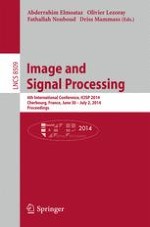2014 | Buch
Image and Signal Processing
6th International Conference, ICISP 2014, Cherbourg, France, June 30 – July 2, 2014. Proceedings
herausgegeben von: Abderrahim Elmoataz, Olivier Lezoray, Fathallah Nouboud, Driss Mammass
Verlag: Springer International Publishing
Buchreihe : Lecture Notes in Computer Science
